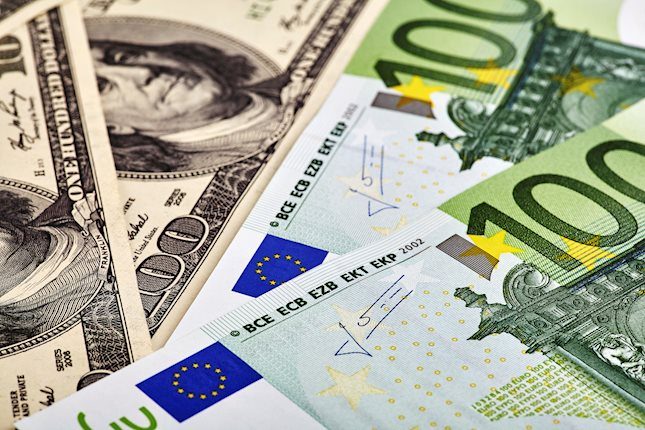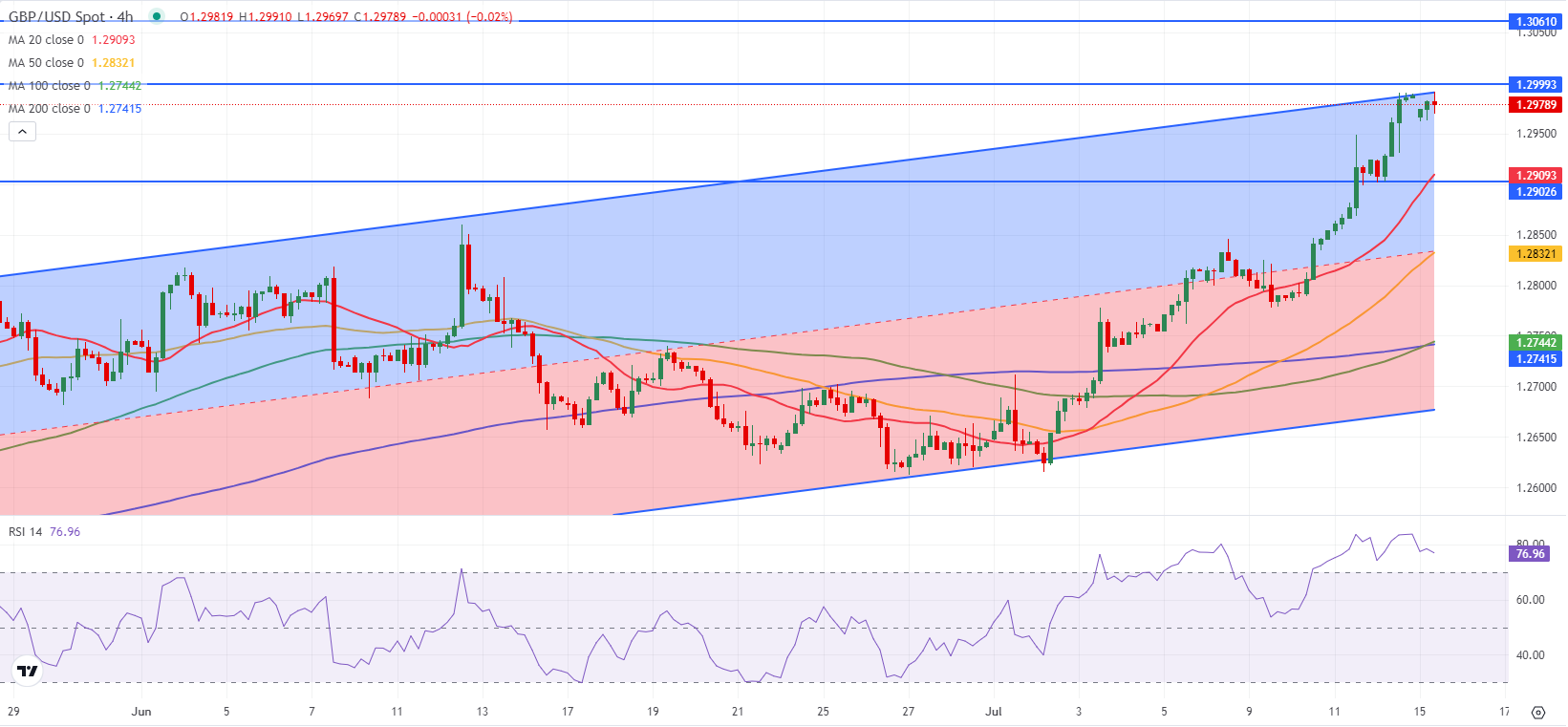- GBP/USD trades below 1.3000 following previous week's rally.
- Fed Chairman Powell will speak at the Economic Club of Washington later in the day.
- The technical outlook suggests that the pair remains technically overbought.
After gaining more than 1% for the second consecutive week, GBP/USD stays in a consolidation phase below 1.3000 on Monday. The pair's technical picture continues to point to overbought conditions as markets wait for Federal Reserve (Fed) Chairman Jerome Powell to speak at the Economic Club of Washington later in the day.
British Pound PRICE Last 7 days
The table below shows the percentage change of British Pound (GBP) against listed major currencies last 7 days. British Pound was the strongest against the New Zealand Dollar.
| USD | EUR | GBP | JPY | CAD | AUD | NZD | CHF | |
|---|---|---|---|---|---|---|---|---|
| USD | -0.66% | -1.26% | -1.71% | -0.01% | -0.42% | 0.71% | -0.25% | |
| EUR | 0.66% | -0.40% | -0.69% | 0.97% | 0.41% | 1.72% | 0.75% | |
| GBP | 1.26% | 0.40% | -0.35% | 1.40% | 0.82% | 2.13% | 1.16% | |
| JPY | 1.71% | 0.69% | 0.35% | 1.72% | 1.32% | 2.61% | 1.53% | |
| CAD | 0.01% | -0.97% | -1.40% | -1.72% | -0.45% | 0.72% | -0.22% | |
| AUD | 0.42% | -0.41% | -0.82% | -1.32% | 0.45% | 1.31% | 0.34% | |
| NZD | -0.71% | -1.72% | -2.13% | -2.61% | -0.72% | -1.31% | -0.96% | |
| CHF | 0.25% | -0.75% | -1.16% | -1.53% | 0.22% | -0.34% | 0.96% |
The heat map shows percentage changes of major currencies against each other. The base currency is picked from the left column, while the quote currency is picked from the top row. For example, if you pick the British Pound from the left column and move along the horizontal line to the US Dollar, the percentage change displayed in the box will represent GBP (base)/USD (quote).
The broad-based selling pressure surrounding the US Dollar (USD) fuelled GBP/USD's rally last week. Softer-than-expected inflation data from June fed into expectations for a Fed rate cut in September and caused the USD to weaken against its rivals. According to the CME FedWatch Tool, the probability of the Fed leaving the policy rate unchanged in September is now less than 6%.
The US economic calendar will not feature any high-impact macroeconomic data releases on Monday. US Retail Sales data on Tuesday and UK inflation data on Wednesday will be this week's key data releases. Ahead of these data, Fed Chairman Powell's remarks will be watched closely by market participants.
In case Powell acknowledges soft inflation data and adopts a dovish tone, the USD could stay under pressure with market participants anticipating multiple rate cuts later in the year, even though the market positioning suggests that a September rate reduction is nearly fully priced in.
On the other hand, the USD could gather strength and cause GBP/USD to stretch lower if Powell reiterates the data-dependent approach and downplays the latest decline in inflation.
GBP/USD Technical Analysis
The Relative Strength Index (RSI) indicator on the 4-hour chart stays well above 70 despite the latest retreat, suggesting that GBP/USD remains technically overbought. The upper limit of the ascending regression channel coming from late April stays intact as key resistance at 1.3000. While this level holds, buyers could stay on the sidelines and allow an extended correction.
On the downside, 1.2950 (static level) aligns as interim support before 1.2900 (psychological level, static level) and 1.2830 (mid-point of the ascending channel).
If GBP/USD manages to rise above 1.3000 and stabilize there, 1.3040 (static level from July 2023) could be seen as next resistance before 1.3100 (psychological level, static level).
Pound Sterling FAQs
The Pound Sterling (GBP) is the oldest currency in the world (886 AD) and the official currency of the United Kingdom. It is the fourth most traded unit for foreign exchange (FX) in the world, accounting for 12% of all transactions, averaging $630 billion a day, according to 2022 data. Its key trading pairs are GBP/USD, aka ‘Cable’, which accounts for 11% of FX, GBP/JPY, or the ‘Dragon’ as it is known by traders (3%), and EUR/GBP (2%). The Pound Sterling is issued by the Bank of England (BoE).
The single most important factor influencing the value of the Pound Sterling is monetary policy decided by the Bank of England. The BoE bases its decisions on whether it has achieved its primary goal of “price stability” – a steady inflation rate of around 2%. Its primary tool for achieving this is the adjustment of interest rates. When inflation is too high, the BoE will try to rein it in by raising interest rates, making it more expensive for people and businesses to access credit. This is generally positive for GBP, as higher interest rates make the UK a more attractive place for global investors to park their money. When inflation falls too low it is a sign economic growth is slowing. In this scenario, the BoE will consider lowering interest rates to cheapen credit so businesses will borrow more to invest in growth-generating projects.
Data releases gauge the health of the economy and can impact the value of the Pound Sterling. Indicators such as GDP, Manufacturing and Services PMIs, and employment can all influence the direction of the GBP. A strong economy is good for Sterling. Not only does it attract more foreign investment but it may encourage the BoE to put up interest rates, which will directly strengthen GBP. Otherwise, if economic data is weak, the Pound Sterling is likely to fall.
Another significant data release for the Pound Sterling is the Trade Balance. This indicator measures the difference between what a country earns from its exports and what it spends on imports over a given period. If a country produces highly sought-after exports, its currency will benefit purely from the extra demand created from foreign buyers seeking to purchase these goods. Therefore, a positive net Trade Balance strengthens a currency and vice versa for a negative balance.
Information on these pages contains forward-looking statements that involve risks and uncertainties. Markets and instruments profiled on this page are for informational purposes only and should not in any way come across as a recommendation to buy or sell in these assets. You should do your own thorough research before making any investment decisions. FXStreet does not in any way guarantee that this information is free from mistakes, errors, or material misstatements. It also does not guarantee that this information is of a timely nature. Investing in Open Markets involves a great deal of risk, including the loss of all or a portion of your investment, as well as emotional distress. All risks, losses and costs associated with investing, including total loss of principal, are your responsibility. The views and opinions expressed in this article are those of the authors and do not necessarily reflect the official policy or position of FXStreet nor its advertisers. The author will not be held responsible for information that is found at the end of links posted on this page.
If not otherwise explicitly mentioned in the body of the article, at the time of writing, the author has no position in any stock mentioned in this article and no business relationship with any company mentioned. The author has not received compensation for writing this article, other than from FXStreet.
FXStreet and the author do not provide personalized recommendations. The author makes no representations as to the accuracy, completeness, or suitability of this information. FXStreet and the author will not be liable for any errors, omissions or any losses, injuries or damages arising from this information and its display or use. Errors and omissions excepted.
The author and FXStreet are not registered investment advisors and nothing in this article is intended to be investment advice.
Recommended Content
Editors’ Picks

EUR/USD sits at yearly lows near 1.0550 ahead of EU GDP, US PPI data
EUR/USD is trading near 1.0550 in the European session on Thursday, sitting at the lowest level in a year. The Trump trades-driven relentless US Dollar buying and German political instability weigh on the pair. Traders await EU GDP data and US PPI report ahead of Fed Chair Powell's speech.

GBP/USD holds losses below 1.2700 on sustained US Dollar strength
GBP/USD is holding losses near multi-month lows below 1.2700 in European trading on Thursday. The pair remains vulnerable amid a broadly firmer US Dollar and softer risk tone even as BoE policymakers stick to a cautious stance on policy. Speeches from Powell and Bailey are eyed.

Gold price hits fresh two-month low as the post-election USD rally remains uninterrupted
Gold price drifts lower for the fifth consecutive day and drops to its lowest level since September 19, around the $2,554-2,553 region heading into the European session on Thursday. The commodity continues to be weighed down by an extension of the US Dollar's post-election rally to a fresh year-to-date.

XRP struggles near $0.7440, could still sustain rally after Robinhood listing
Ripple's XRP is trading near $0.6900, down nearly 3% on Wednesday, as declining open interest could extend its price correction. However, other on-chain metrics point to a long-term bullish setup.

Trump vs CPI
US CPI for October was exactly in line with expectations. The headline rate of CPI rose to 2.6% YoY from 2.4% YoY in September. The core rate remained steady at 3.3%. The detail of the report shows that the shelter index rose by 0.4% on the month, which accounted for 50% of the increase in all items on a monthly basis.

Best Forex Brokers with Low Spreads
VERIFIED Low spreads are crucial for reducing trading costs. Explore top Forex brokers offering competitive spreads and high leverage. Compare options for EUR/USD, GBP/USD, USD/JPY, and Gold.
